
by KratomUSA | Aug 12, 2025 | Kratom
🌱 Explore the Chemical Nature, Effects, and Regulatory Concerns Surrounding 7-Hydroxymitragynine
Kratom has gained increasing attention for its unique alkaloids and potential effects, but among these compounds, 7-Hydroxymitragynine stands out due to its powerful impact on the body. So what is 7-Hydroxymitragynine?
Found naturally in the kratom plant in small amounts, this alkaloid is known for its potent opioid-like effects, which have sparked both interest and concern within scientific, medical, and regulatory communities. In this article, we’ll explore what 7-Hydroxymitragynine is, its effects, health considerations, and why many experts recommend using full-spectrum kratom products instead of isolated extracts for a safer and more balanced experience.
🔑 Key Points
-
Chemical Nature: 7-Hydroxymitragynine (7-OH) is a terpenoid indole alkaloid found in the kratom plant (Mitragyna speciosa).
-
Potency: It is significantly more potent than mitragynine, the primary alkaloid in kratom, and has opioid-like effects.
-
Regulatory Concerns: Due to its potency and potential for abuse, the FDA has recommended classifying 7-OH as a Schedule I controlled substance.
-
Legal Status: While kratom remains legal in many areas, 7-OH is increasingly under scrutiny and facing regulatory actions.
🌿 What Is 7-Hydroxymitragynine?
7-Hydroxymitragynine is a naturally occurring alkaloid in the kratom plant. It is produced as an active metabolite of mitragynine, the primary alkaloid in kratom, through hepatic oxidation. While present in trace amounts in the raw plant, modern extraction techniques have enabled the production of concentrated 7-OH products.
⚖️ Potency and Effects
7-Hydroxymitragynine exhibits a significantly higher binding affinity to μ-opioid receptors compared to mitragynine, making it substantially more potent. This increased potency contributes to its pronounced analgesic and sedative effects.
🧪 Health Implications
Due to its opioid-like properties, 7-OH carries a risk of dependence and withdrawal symptoms. The U.S. Food and Drug Administration (FDA) has issued warning letters to companies marketing products containing 7-OH, highlighting concerns.
📉 Regulatory Actions
In July 2025, the FDA recommended classifying 7-Hydroxymitragynine as a Schedule I controlled substance, indicating high potential for abuse and no accepted medical use.
🌿 Why Choose Full-Spectrum Kratom Over Isolated 7-Hydroxymitragynine?
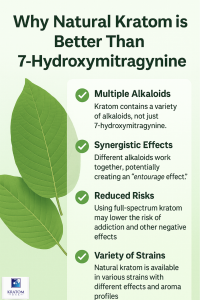 While 7-hydroxymitragynine (7-OH) is a highly potent alkaloid in kratom, many experts and users advocate for using full-spectrum kratom products instead of isolated compounds. Full-spectrum kratom contains a diverse profile of alkaloids—including mitragynine, speciociliatine, paynantheine, and others—that work synergistically to create what is often referred to as the “entourage effect.”
While 7-hydroxymitragynine (7-OH) is a highly potent alkaloid in kratom, many experts and users advocate for using full-spectrum kratom products instead of isolated compounds. Full-spectrum kratom contains a diverse profile of alkaloids—including mitragynine, speciociliatine, paynantheine, and others—that work synergistically to create what is often referred to as the “entourage effect.”
This synergy can provide a more balanced and nuanced experience compared to isolated 7-OH, which may produce stronger but less well-rounded effects. Full-spectrum kratom tends to offer a combination of stimulating, relaxing, and mood-enhancing properties, reducing the likelihood of intense side effects such as rapid tolerance development or withdrawal symptoms often associated with high doses of single alkaloids.
Moreover, full-spectrum kratom is typically considered safer and better suited for long-term use due to its natural composition. It allows the body to benefit from the complex interaction of multiple alkaloids, as nature intended, rather than the concentrated impact of one isolated chemical.
Many kratom advocates recommend starting with full-spectrum extracts or powders before considering concentrated alkaloid isolates, especially because the latter carries a higher risk of adverse effects and regulatory scrutiny.
🔍 Frequently Asked Questions (FAQ)
Q1: Is 7-Hydroxymitragynine the same as kratom?
No, 7-Hydroxymitragynine is a potent alkaloid found in kratom but is not the same as the whole plant.
Q2: What are the risks associated with 7-Hydroxymitragynine?
Risks include addiction, withdrawal symptoms, and potential overdose, especially when consumed in concentrated forms.
Q3: Is 7-Hydroxymitragynine legal?
Its legal status varies by jurisdiction. In the U.S., the FDA has recommended its classification as a Schedule I controlled substance.
Q4: How is 7-Hydroxymitragynine consumed?
It is typically consumed through products like tablets, gummies, and energy drinks containing concentrated extracts.
Q5: Can 7-Hydroxymitragynine be used safely?
Due to its potency and potential health risks, its use is not recommended without medical supervision.
Note: The information provided in this article is for educational purposes only and is not intended to diagnose, treat, cure, or prevent any disease. Always consult with a healthcare professional before using any new supplement or product.

by KratomUSA | Aug 11, 2025 | Kratom
🌱 Explore the Benefits of Kratom USA’s Premium Kratom Tincture 110 MIT
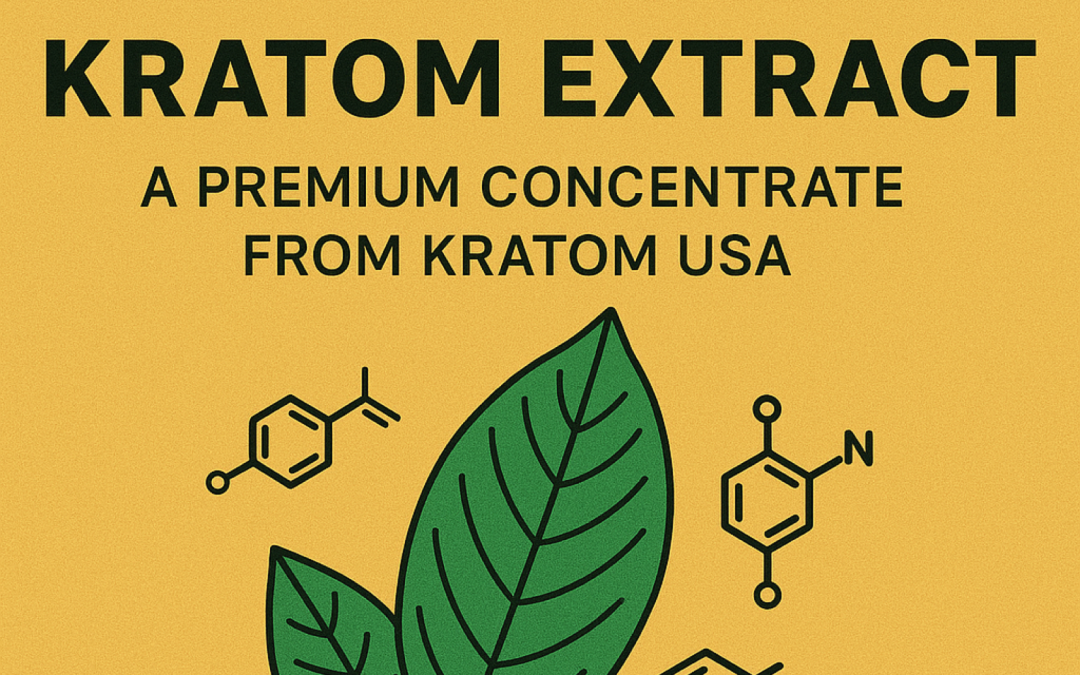
by KratomUSA | Aug 5, 2025 | Kratom
✨ Gold Reserve Kratom Extract: The Premium Blend for Potency and Purity
Discover Kratom USA’s Signature Concentrate Loved by Experienced Users Nationwide
Kratom USA’s Gold Reserve Kratom Extract has built a reputation as one of the most premium kratom concentrates available today. Known for its high alkaloid content, refined extraction process, and trusted sourcing, this blend is crafted for those who seek a next-level kratom experience.
But what exactly is Gold Reserve Extract? Why is it so highly regarded? And how does it compare to other kratom products? This guide breaks it all down so you can decide if it’s right for your routine.
🔑 Key Points
-
Gold Reserve Kratom Extract is a highly concentrated blend of kratom alkaloids and finely ground leaf powder.
-
Sourced and manufactured by Kratom USA, one of the oldest and most reputable vendors in the U.S.
-
May offer a stronger, longer-lasting experience than traditional powders or capsules.
-
Crafted for experienced users seeking a premium product with consistency and reliability.
-
Available for purchase online at KratomUSA.com.
🌿 What Is Gold Reserve Kratom Extract?
Gold Reserve Extract isn’t just a flashy name—it’s a signature blend known for its highly refined concentration. This product combines purified kratom alkaloids (typically from Mitragyna speciosa) with a small amount of high-quality kratom leaf powder to ensure a balanced and smooth delivery.
The result? A powerful extract that offers a unique synergy of alkaloids and plant material.
⚗️ How It’s Made: A Refined Extraction Process
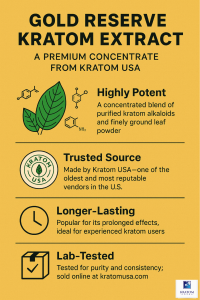 Kratom USA uses a specialized extraction and blending method to isolate and preserve the most active alkaloids—primarily mitragynine and 7-hydroxymitragynine, believed to be responsible for kratom’s effects.
Kratom USA uses a specialized extraction and blending method to isolate and preserve the most active alkaloids—primarily mitragynine and 7-hydroxymitragynine, believed to be responsible for kratom’s effects.
These purified alkaloids are then reintroduced into a base of fine kratom powder. This double-layered approach allows for extended shelf life, easier handling, and a richer user experience.
💥 What Makes Gold Reserve Extract So Popular?
Here’s what makes Gold Reserve stand out in a sea of kratom products:
-
High potency in a small dose
-
Backed by Kratom USA’s two decades of trust
-
Crafted in small batches for quality control
-
Contains no additives or synthetic fillers
-
Ideal for advanced users or occasional high-impact support
👥 What Real Users Say
“Gold Reserve is my go-to when I need a serious boost in focus and mood. I only need a tiny amount to feel it working.”
— James R., Florida
“I’ve tried other extracts, but this one from Kratom USA is by far the smoothest and most reliable.”
— Megan L., Oregon
“Perfect for when regular kratom just doesn’t cut it. Potent, but not overwhelming. Love it!”
— Anthony K., Texas
🔬 What Does the Science Say?
While Gold Reserve is a proprietary product, it is made using well-studied kratom alkaloids:
-
Mitragynine is the most abundant alkaloid and may interact with opioid receptors【Hemby et al., 2019 – Drug and Alcohol Dependence】.
-
7-hydroxymitragynine is more potent by weight and may contribute to more noticeable effects.
-
Concentrated extracts like Gold Reserve are increasingly used by people seeking support for occasional discomfort, mood, or energy—though more formal studies are needed.
⚠️ Always consult your healthcare provider before trying kratom or its extracts.
🧠 Who Should Use Gold Reserve Kratom?
This extract is not intended for beginners due to its strength. Instead, it’s best for:
If you’re newer to kratom, consider starting with a milder powder before graduating to a concentrated extract.
🛒 Where to Buy Gold Reserve Extract
You can purchase Gold Reserve Kratom Extract exclusively at:
👉 https://kratomusa.com/product/gold-reserve-extract/
All products from Kratom USA are:
-
✅ Lab-tested for purity and potency
-
✅ Packaged in GMP-compliant facilities
-
✅ Backed by over 20 years of industry experience
📦 How to Use It
Gold Reserve Extract is typically used in smaller quantities than traditional kratom powder.
-
Start with 1 capsule to assess tolerance.
-
Can be mixed into tea or taken in capsule form.
-
Avoid daily use to prevent tolerance buildup.
❓ FAQ: Gold Reserve Kratom Extract
How strong is Gold Reserve compared to regular kratom?
Gold Reserve is significantly more potent. A little goes a long way, so users should start with a very small dose.
Is Gold Reserve safe?
When used responsibly and purchased from a trusted vendor like Kratom USA, it can be safe for experienced users. Always follow dosage guidelines and avoid mixing with other substances.
Can I use this if I’m new to kratom?
It’s recommended for seasoned users. Beginners should start with traditional powder or capsules.
Is this legal in my state?
Kratom legality varies by location. Check Kratom USA’s shipping policy or your state laws before ordering.
✅ Final Thoughts
If you’re looking for a premium kratom extract that delivers consistent strength, quality sourcing, and trusted results, Gold Reserve Kratom Extract from Kratom USA is a standout choice.
Backed by decades of experience, Kratom USA continues to set the standard in the industry—and their Gold Reserve blend is a testament to that legacy.
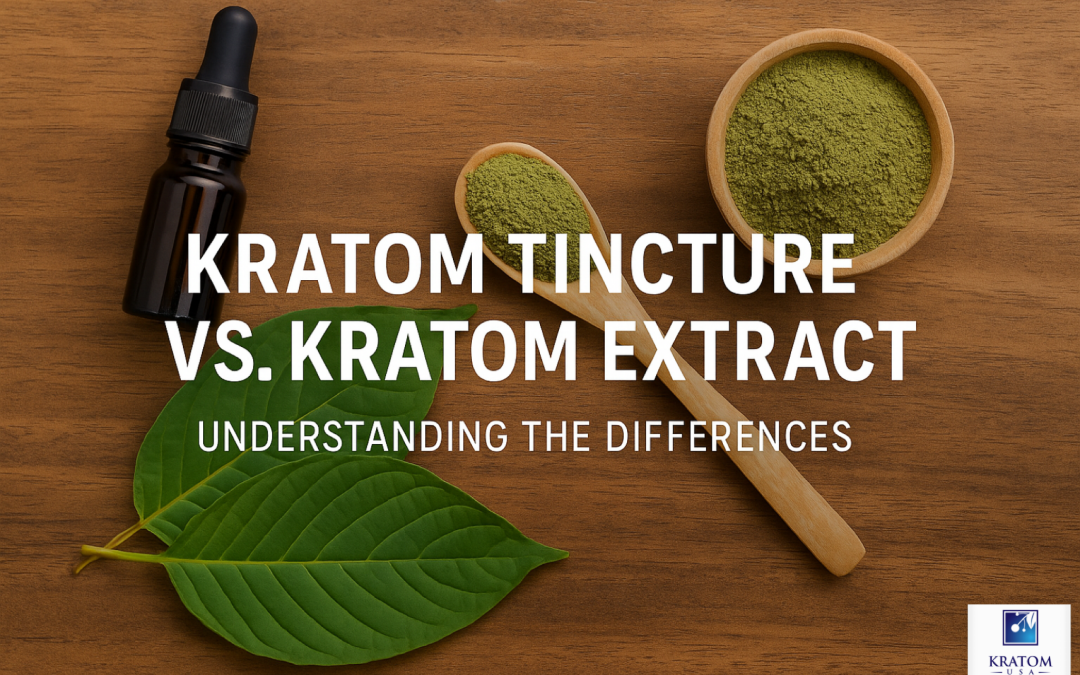
by KratomUSA | Jul 29, 2025 | Kratom
🌿 What’s the Difference and Which One Is Right for You?
Kratom has evolved far beyond its traditional powdered leaf form. Today’s market offers concentrated options like kratom tinctures and kratom extracts, both designed to deliver a more potent experience—but what’s the real difference between kratom tincture versus extract?
Whether you’re curious about how tinctures work, wondering if extracts are stronger, or trying to figure out which is best for your needs, this guide will help you make an informed decision.
🔑 Key Points
-
Kratom tinctures are alcohol-based liquid concentrates made by steeping kratom in ethanol or another solvent.
-
Kratom extracts are highly concentrated powders or resins created by boiling down the plant material.
-
Tinctures are typically easier to measure and dose; extracts are often stronger and more versatile.
-
Both options may provide longer-lasting effects, but potency, onset time, and user experience vary.
-
Always choose products from trusted, lab-tested vendors to ensure safety and consistency.
💧 What Is a Kratom Tincture?
A kratom tincture is a liquid extract created by soaking kratom leaves or powder in a solvent—usually ethanol—over an extended period. This process pulls out the plant’s alkaloids, especially mitragynine and 7-hydroxymitragynine, which are believed to be responsible for many of kratom’s effects.
Pros of kratom tinctures:
-
Easy to dose with a dropper
-
Long shelf life (thanks to alcohol base)
-
Convenient and portable
-
Fast absorption under the tongue (sublingual use)
Cons:
🧪 What Is a Kratom Extract?
Kratom extracts are made by boiling kratom powder or leaves into a concentrated paste, resin, or fine powder. They are typically labeled with ratios like 10x or 50x, meaning the amount of kratom used in the process (though this doesn’t always reflect potency).
Types of extracts:
-
Powdered extracts – looks like regular kratom but much stronger
-
Resin extracts – solid or sticky blocks
-
Liquid extracts – similar to tinctures but may not use alcohol
Pros of kratom extracts:
Cons:
⚖️ Tincture vs. Extract: Side-by-Side Comparison
| Feature |
Kratom Tincture |
Kratom Extract |
| Form |
Liquid |
Powder/Resin/Liquid |
| Potency |
Moderate to High |
High to Very High |
| Absorption Speed |
Fast (sublingual) |
Depends on form |
| Taste |
Bitter (alcohol) |
Bitter or earthy |
| Shelf Life |
Long (alcohol-preserved) |
Varies (depends on form) |
| Ease of Use |
Dropper dosing |
Requires careful measuring |
| Best For |
Discreet use, convenience |
High-potency users |
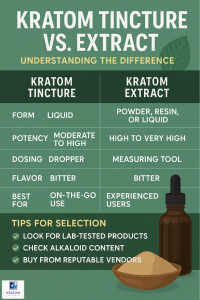 💬 What Real Users Say
💬 What Real Users Say
“I love tinctures for on-the-go. A couple drops under the tongue and I’m good for hours without messing with powder.”
— Rachel T., 34
“Kratom extracts give me the relief I need when my regular dose isn’t cutting it. But I have to be careful not to take too much.”
— Marcus B., 42
“Tinctures feel smoother for me than extracts. It’s more subtle but lasts just as long.”
— Eli J., 29
📚 What Do Studies Say?
While formal research on tinctures and extracts is limited, we do know that:
-
Mitragynine and 7-hydroxymitragynine are the primary alkaloids responsible for kratom’s psychoactive effects.
-
The concentration and absorption of these alkaloids can vary greatly depending on the preparation method.
-
Anecdotal reports from surveys (like the 2020 Johns Hopkins kratom study) show that users often turn to concentrated forms for stronger, longer-lasting effects.
🧠 Who Should Use Which?
💧 Use a tincture if you:
-
Prefer discreet or on-the-go options
-
Want easy, accurate dosing
-
Are new to concentrated kratom products
🧪 Use an extract if you:
🛒 Tips for Choosing Quality Products
-
✅ Look for lab-tested products
-
✅ Check for alkaloid concentration on the label
-
✅ Avoid anything that doesn’t disclose ingredients or source
-
✅ Purchase from reputable vendors with consistent reviews
❓ FAQ: Kratom Tincture vs. Extract
What’s stronger—kratom tincture or extract?
Extracts are generally more potent by volume, but tinctures may absorb faster when used sublingually.
Are tinctures safer than extracts?
Tinctures are easier to dose precisely, making them a better starting point for beginners.
Can I use both tinctures and extracts?
Yes, but alternating use can help prevent building up a tolerance too quickly.
Do kratom tinctures contain alcohol?
Most do, but some vendors offer glycerin-based or alcohol-free tinctures.
Are these products legal?
Kratom’s legality varies by state and country. Check local laws before purchasing.
✅ Final Thoughts
Both kratom tinctures and kratom extracts offer unique benefits depending on your preferences and experience level. Tinctures are discreet, convenient, and ideal for controlled dosing. Extracts offer powerful effects, but should be approached with caution and respect.
Whether you’re new to concentrated kratom or looking to upgrade your experience, the key is to choose high-quality products from trusted vendors—and always start low, go slow.
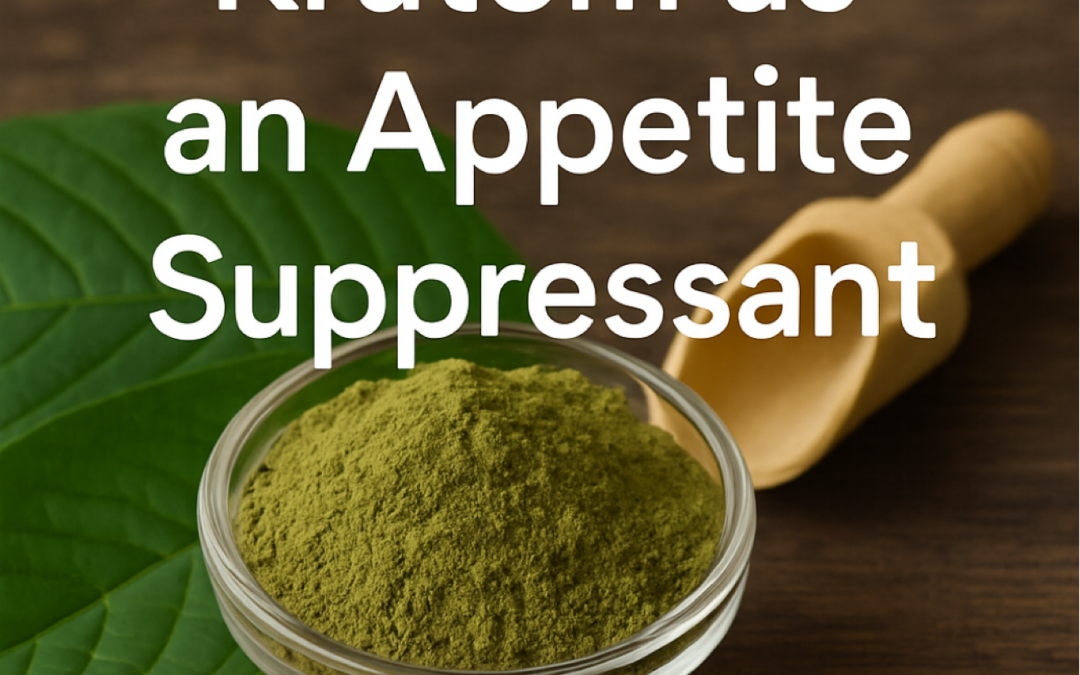
by KratomUSA | Jul 28, 2025 | Kratom
🌿 Exploring Its Surprising Effect on Hunger
As kratom becomes more mainstream, people are discovering it does more than just support mood, energy, and discomfort relief. One emerging question is: Can kratom suppress appetite? While kratom is not a weight loss supplement, many users report a noticeable reduction in hunger after taking certain strains. But is there science to support these experiences?
This article breaks down how kratom may influence appetite, what strains are most commonly associated with hunger suppression, and what users are saying.
🔑 Key Points
-
Kratom may suppress appetite in some users due to its interaction with neurotransmitters.
-
This effect seems most common with white and green vein strains.
-
Appetite suppression is often reported as a side effect, not the primary reason for use.
-
More research is needed, but anecdotal reports are consistent and widespread.
-
Kratom is not a weight-loss drug and should be used responsibly.
🧬 How Kratom Might Affect Hunger
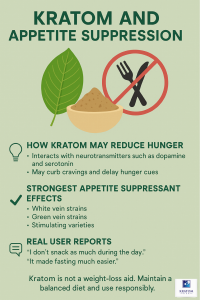 Kratom (Mitragyna speciosa) contains alkaloids like mitragynine and 7-hydroxymitragynine, which bind to opioid receptors in the brain. These interactions don’t just impact discomfort and mood—they may also influence appetite-regulating hormones and neurotransmitters like:
Kratom (Mitragyna speciosa) contains alkaloids like mitragynine and 7-hydroxymitragynine, which bind to opioid receptors in the brain. These interactions don’t just impact discomfort and mood—they may also influence appetite-regulating hormones and neurotransmitters like:
-
Dopamine (pleasure and reward)
-
Serotonin (mood and satiety)
-
Norepinephrine (alertness and energy)
Because of this, kratom may lead to:
A study cited in the National Library of Medicine noted that kratom users frequently report decreased appetite as a secondary effect of use—especially with stimulating strains.
🧠 Appetite Suppression vs. Stimulant Effects
Many of the strains associated with appetite suppression are also known for their stimulating or mood-lifting effects. This is a pattern seen with other stimulants as well—think coffee or ADHD medications like Adderall.
Some kratom users say that after a dose:
-
They feel too energized to focus on eating
-
They forget meals due to heightened productivity or focus
-
Their emotional eating tendencies reduce due to better mood balance
However, this effect is not universal. Some users report no change in appetite or even slight increases depending on dose and strain.
🌿 Best Kratom Strains for Appetite Suppression
Here are the strains most commonly reported to suppress hunger:
✅ White Vein Strains
✅ Green Vein Strains
-
Balanced effects with mild stimulation
-
May curb appetite without excessive jitteriness
-
Popular choices: Green Malay, Green Maeng Da
⚠️ Red Vein Strains
-
More sedating and calming
-
Less commonly associated with appetite suppression
-
May increase appetite in some cases
💬 Real User Experiences
“I take White Maeng Da in the mornings and I completely forget about breakfast. Not on purpose—it just keeps me focused and not thinking about food.”
— Alicia T., 38
“Green Malay helps me stay productive, and I don’t snack nearly as much when I use it. Definitely a bonus I didn’t expect!”
— Kevin R., 42
“When I’m on kratom, especially white strains, I can go 5–6 hours without even thinking about eating. It’s made intermittent fasting way easier.”
— Sandra V., 29
⚖️ Responsible Use: Kratom Is Not a Diet Pill
While appetite suppression may be a useful side effect for some users, it’s important to note:
-
Kratom is not intended for weight loss
-
Prolonged appetite suppression can lead to nutritional deficiencies
-
Skipping meals may worsen kratom’s potential side effects (nausea, dizziness)
-
Always eat balanced meals and stay hydrated
If appetite suppression is significant or persistent, users should monitor their food intake and consider adjusting their dosage or strain.
🧪 Is There Any Scientific Backing?
While human clinical research is still limited, early studies hint at kratom’s impact on metabolism and energy regulation:
-
A study in Drug and Alcohol Dependence found that kratom’s alkaloids interact with the opioid and adrenergic systems, both of which play a role in appetite and energy expenditure.
-
Animal studies in Southeast Asia suggest mitragynine may influence ghrelin and leptin, hormones that regulate hunger and fullness—but more research is needed to confirm these effects in humans.
📝 Tips for Managing Appetite While Using Kratom
-
✅ Eat a light meal or snack before dosing to avoid nausea.
-
✅ If using kratom for productivity or energy, schedule meals to avoid skipping them.
-
✅ Monitor your daily calorie intake if you’re unintentionally eating less.
-
✅ Use kratom in moderation to prevent developing tolerance.
❓ FAQ: Kratom and Appetite Suppression
Does kratom reduce appetite?
Many users report reduced hunger as a side effect, especially with stimulating strains like white and green veins.
Is kratom a safe weight-loss supplement?
Kratom is not FDA-approved for weight loss and should not be used as a diet pill. Any appetite suppression should be managed responsibly.
Why does kratom make me forget to eat?
Some alkaloids in kratom may influence mood, energy, and focus, which can distract from hunger cues.
Will red kratom make me less hungry too?
Red vein strains are more relaxing and may not have the same appetite-suppressing effects as white or green strains.
Is it dangerous to skip meals on kratom?
It can be. Taking kratom on an empty stomach may increase nausea or dizziness. It’s important to maintain healthy eating habits.
✅ Final Thoughts
While kratom is not a weight-loss aid, its potential to suppress appetite is real for many users—especially those taking white and green strains. If you’ve noticed reduced hunger while using kratom, it’s likely linked to the plant’s stimulating and mood-enhancing effects.
The key is balance. Always listen to your body, eat regularly, and use kratom mindfully. As research evolves, we may learn even more about how this fascinating plant interacts with appetite and metabolism.

 While 7-hydroxymitragynine (7-OH) is a highly potent alkaloid in kratom, many experts and users advocate for using full-spectrum kratom products instead of isolated compounds. Full-spectrum kratom contains a diverse profile of alkaloids—including mitragynine, speciociliatine, paynantheine, and others—that work synergistically to create what is often referred to as the “entourage effect.”
While 7-hydroxymitragynine (7-OH) is a highly potent alkaloid in kratom, many experts and users advocate for using full-spectrum kratom products instead of isolated compounds. Full-spectrum kratom contains a diverse profile of alkaloids—including mitragynine, speciociliatine, paynantheine, and others—that work synergistically to create what is often referred to as the “entourage effect.”


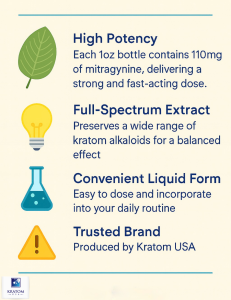 Premium Kratom Tincture 110 MIT is a liquid extract derived from high-quality kratom leaves.
Premium Kratom Tincture 110 MIT is a liquid extract derived from high-quality kratom leaves.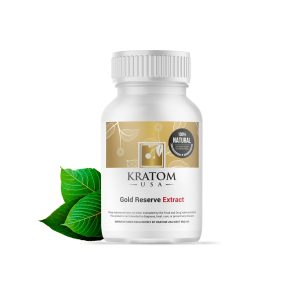
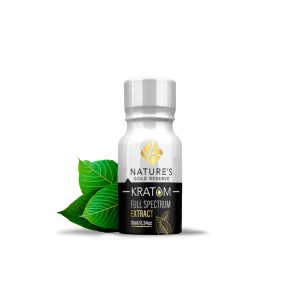

 Kratom USA uses a specialized extraction and blending method to isolate and preserve the most active
Kratom USA uses a specialized extraction and blending method to isolate and preserve the most active 
 💬 What Real Users Say
💬 What Real Users Say
 Kratom (Mitragyna speciosa) contains
Kratom (Mitragyna speciosa) contains